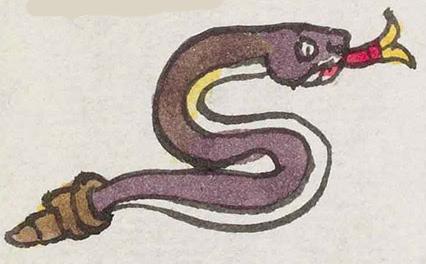Coatlayauhcan (Mdz17v)
This simplex glyph for the place name Coatlyauhcan has two principal elements, the snake or serpent (coatl), which is poised in the shape of an "S," with a purple back and a white belly. It has rattles on its tail, and it has a bifurcated tongue, red nearer the mouth and yellow at the tips. it is looking to our right. Two fangs are visible protruding from the mouth, white on the tips and red at the roots. The rattles have a yellow cover over the purple paint.
Stephanie Wood
The position of the snake is a referent for the verb tlayahua, to make certain gestures while dancing, according to Alexis Wimmer in the Gran Diccionario del Nahuatl. So, the snake holds a dancing posture, perhaps about to strike. There are other representations of snakes that appear to have their heads raised and another where it is curving and upright. See below, right, for comparisons.
Stephanie Wood
coatlayauhcan. puo
Coatlayauhcan, pueblo
Stephanie Wood
c. 1541, or by 1553 at the latest
Stephanie Wood
snakes, serpents, serpientes, dientes, cohuatl, nombres de lugares, crótalos

coa(tl), snake or serpent, https://nahuatl.wired-humanities.org/content/coatl
tlayahua, to make certain gestures while dancing, https://gdn.iib.unam.mx/diccionario/tlayahua/73091
-can (locative suffix), place where, https://nahuatl.wired-humanities.org/content/can-2
"Place of the Coiling Snake" (Karttunen apparently agrees with the Berdan and Anawalt interpretation) [Frances Karttunen, unpublished manuscript, used here with her permission.]
"Place of the Coiling Snake" (Berdan and Anawalt, 1992, vol. 1, p. 179)
Codex Mendoza, folio 17 verso, https://digital.bodleian.ox.ac.uk/objects/2fea788e-2aa2-4f08-b6d9-648c00..., image 45 of 188.
The Bodleian Libraries, University of Oxford, hold the original manuscript, the MS. Arch. Selden. A. 1. This image is published here under the UK Creative Commons, “Attribution-NonCommercial-ShareAlike 3.0 License” (CC-BY-NC-SA 3.0).




